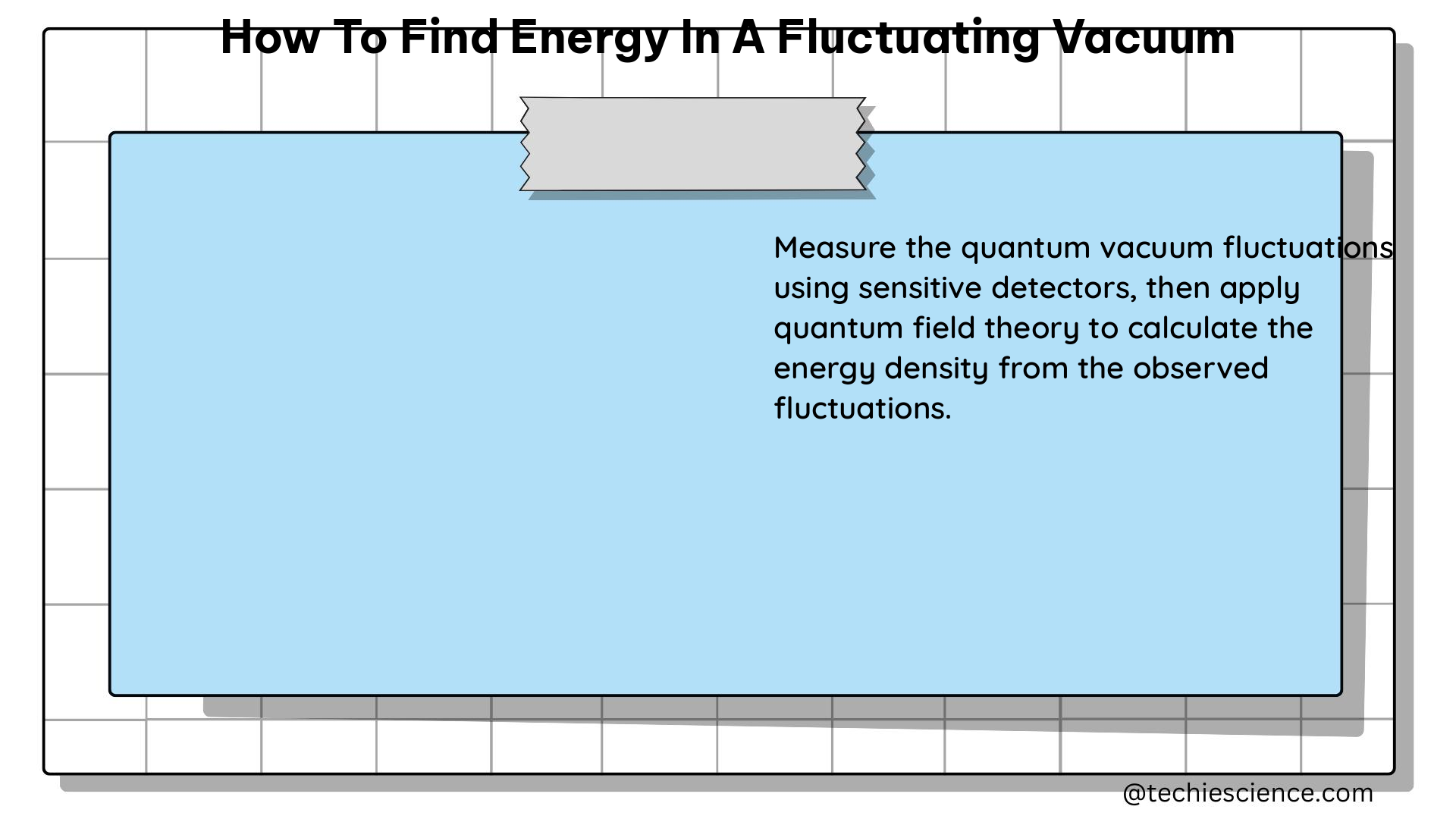Exploring the complex and nuanced topic of finding energy in a fluctuating vacuum requires a deep understanding of quantum field theory (QFT), vacuum fluctuations, renormalization, and the Casimir effect. This comprehensive guide will delve into the technical details and provide practical examples to help you navigate this fascinating field of study.
Vacuum Fluctuations: The Cornerstone of Energy Extraction
Vacuum fluctuations, also known as zero-point fluctuations, are a fundamental aspect of QFT. Quantum systems constantly fluctuate in their lowest energy state due to the Heisenberg uncertainty principle. These fluctuations can lead to divergences, such as the infrared (IR) and ultraviolet (UV) divergences in the Hamiltonian of a quantum system.
IR and UV Divergences
- IR Divergence: Arises from computing the energy in an infinite volume, leading to a non-convergent integral.
- UV Divergence: Occurs due to the non-convergence of the integral for the energy density, resulting in an infinite energy density.
To address these divergences, QFTs are often treated as effective theories with a cutoff on the allowed momenta/energies. This approach is particularly relevant when considering gravity, where the absolute zero energy has a meaning, and the vacuum energy cannot be set to zero at will.
Renormalization: Taming the Divergences

Renormalization is a process in QFT where divergences are addressed by adding a constant energy density to the classical Hamiltonian. This makes the total vacuum energy density zero, even when lifting the cutoff to infinity. Renormalization is a crucial step in understanding the physical implications of vacuum energy and its potential for energy extraction.
The Casimir Effect: Extracting Energy from Vacuum Fluctuations
The Casimir effect is a phenomenon where boundary conditions of the vacuum fluctuations at a thin metal surface result in the transfer of energy from the vacuum fluctuations to electrons in the metal, injecting some into a dielectric and producing a small current. This effect has been used in various applications, including:
- Controlling spontaneous emission
- Altering dispersion forces
- Generating torques and repulsive forces
- Enhancing chemical reactions
- Transferring heat in the vacuum
- Tuning attractive and repulsive forces in microelectromechanical systems
- Inducing entanglement
The Casimir Effect Formula
The Casimir effect can be described by the formula:
$F_C = -\frac{\pi^2 \hbar c A}{240 d^4}$
where:
– $F_C$ is the Casimir force
– $A$ is the area of the plates
– $d$ is the distance between the plates
– $\hbar$ is the reduced Planck constant
– $c$ is the speed of light
Casimir Effect Example
Consider two uncharged, conducting plates placed very close together in a vacuum. The boundary conditions of the vacuum fluctuations at the plates result in a reduction of the vacuum energy density between the plates compared to the vacuum energy density outside. This reduction in energy density creates an attractive force between the plates, known as the Casimir force.
Casimir Effect Numerical Problem
Calculate the Casimir force between two uncharged, conducting plates with an area of 1 cm² and a distance of 100 nm apart. Use the formula:
$F_C = -\frac{\pi^2 \hbar c A}{240 d^4}$
Given:
– Area of the plates, $A$: 1 cm² = 1 x 10^-4 m²
– Distance between the plates, $d$: 100 nm = 1 x 10^-7 m
– Reduced Planck constant, $\hbar$: 1.0545718 x 10^-34 m² kg / s
– Speed of light, $c$: 299,792,458 m/s
Plugging these values into the formula, we get:
$F_C = -\frac{\pi^2 (1.0545718 x 10^-34 m² kg / s) (299,792,458 m/s) (1 x 10^-4 m²)}{240 (1 x 10^-7 m)^4}$
$F_C = -1.30 x 10^-11 N$
Therefore, the Casimir force between the two plates is approximately -1.30 x 10^-11 N, indicating an attractive force between the plates.
The Significance of Vacuum Energy
In the context of finding energy in a fluctuating vacuum, it is essential to understand that the vacuum energy is not merely an artifact of mathematical formalism. It has physical consequences, such as contributing to a cosmological constant in general relativity, which can lead to a cosmological constant problem due to the large discrepancy between the predicted and observed values.
Conclusion
Finding energy in a fluctuating vacuum involves a deep understanding of vacuum fluctuations, renormalization, and the Casimir effect. While there are challenges in measuring and quantifying this energy due to divergences and the need for effective theories, the Casimir effect provides a practical example of how energy can be extracted from vacuum fluctuations under specific boundary conditions. This guide has provided a comprehensive overview of the technical details and practical applications in this fascinating field of study.
References
- Maclay, G. J., & Passante, R. (2023). Vacuum Fluctuations. Physics, 2624-8174.
- Vacuum energy of a real Klein-Gordon field – Physics Stack Exchange. (2017, October 21). Retrieved from https://physics.stackexchange.com/questions/364240/vacuum-energy-of-a-real-klein-gordon-field
- Zero-point energy – Wikipedia. (n.d.). Retrieved from https://en.wikipedia.org/wiki/Zero-point_energy
- Concepts for Extracting Energy From the Quantum Vacuum. (2010, April 6). Retrieved from http://backreaction.blogspot.com/2021/08/physicist-despairs-over-vacuum-energy.html
- DIRD_24-DIRD_Concepts_for_Extracting_Energy_from_the_Quantum_Vacuum.pdf. (2010, April 6). Retrieved from https://documents2.theblackvault.com/documents/dia/AAWSAP-DIRDs/DIRD_24-DIRD_Concepts_for_Extracting_Energy_from_the_Quantum_Vacuum.pdf

The lambdageeks.com Core SME Team is a group of experienced subject matter experts from diverse scientific and technical fields including Physics, Chemistry, Technology,Electronics & Electrical Engineering, Automotive, Mechanical Engineering. Our team collaborates to create high-quality, well-researched articles on a wide range of science and technology topics for the lambdageeks.com website.
All Our Senior SME are having more than 7 Years of experience in the respective fields . They are either Working Industry Professionals or assocaited With different Universities. Refer Our Authors Page to get to know About our Core SMEs.